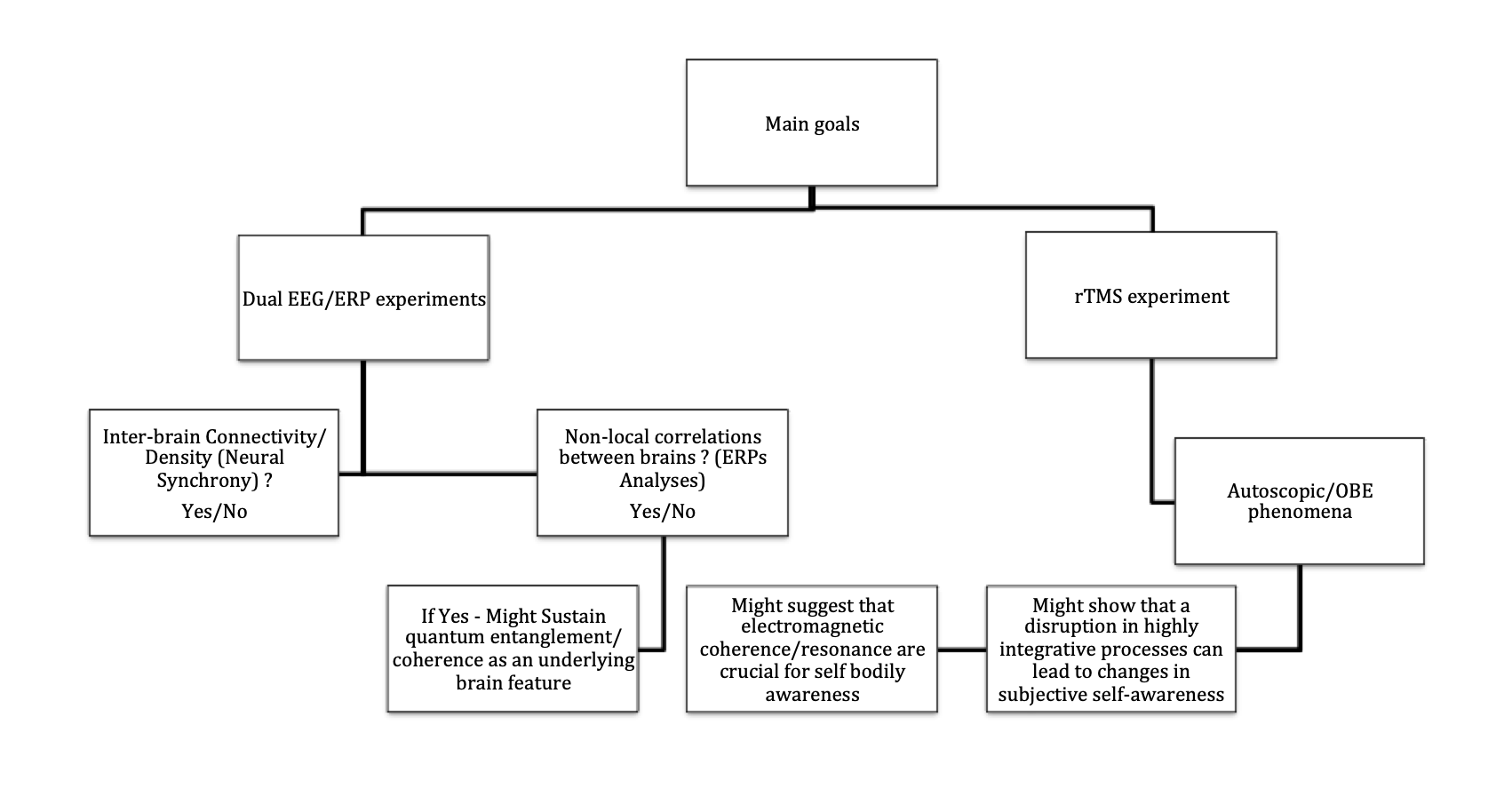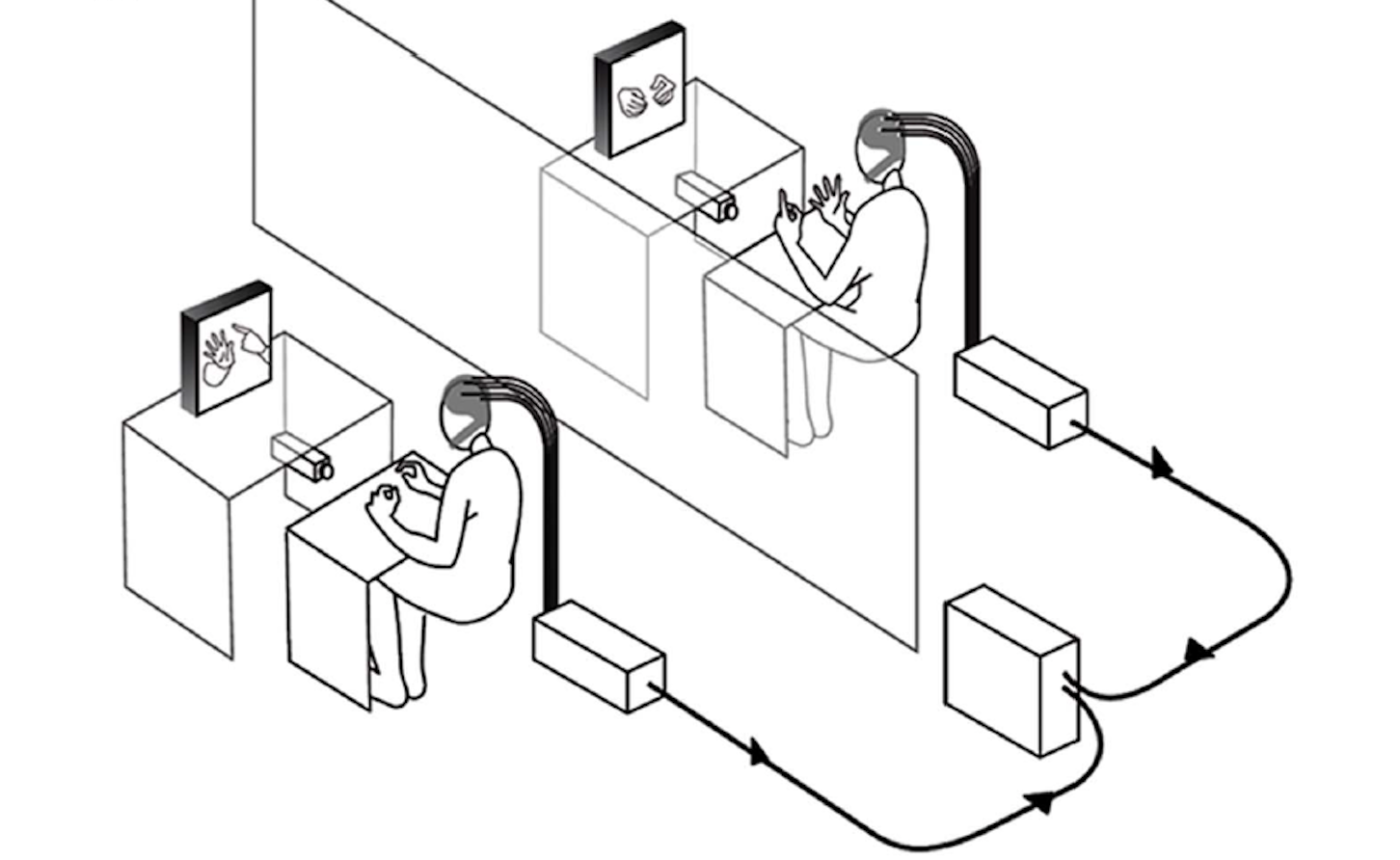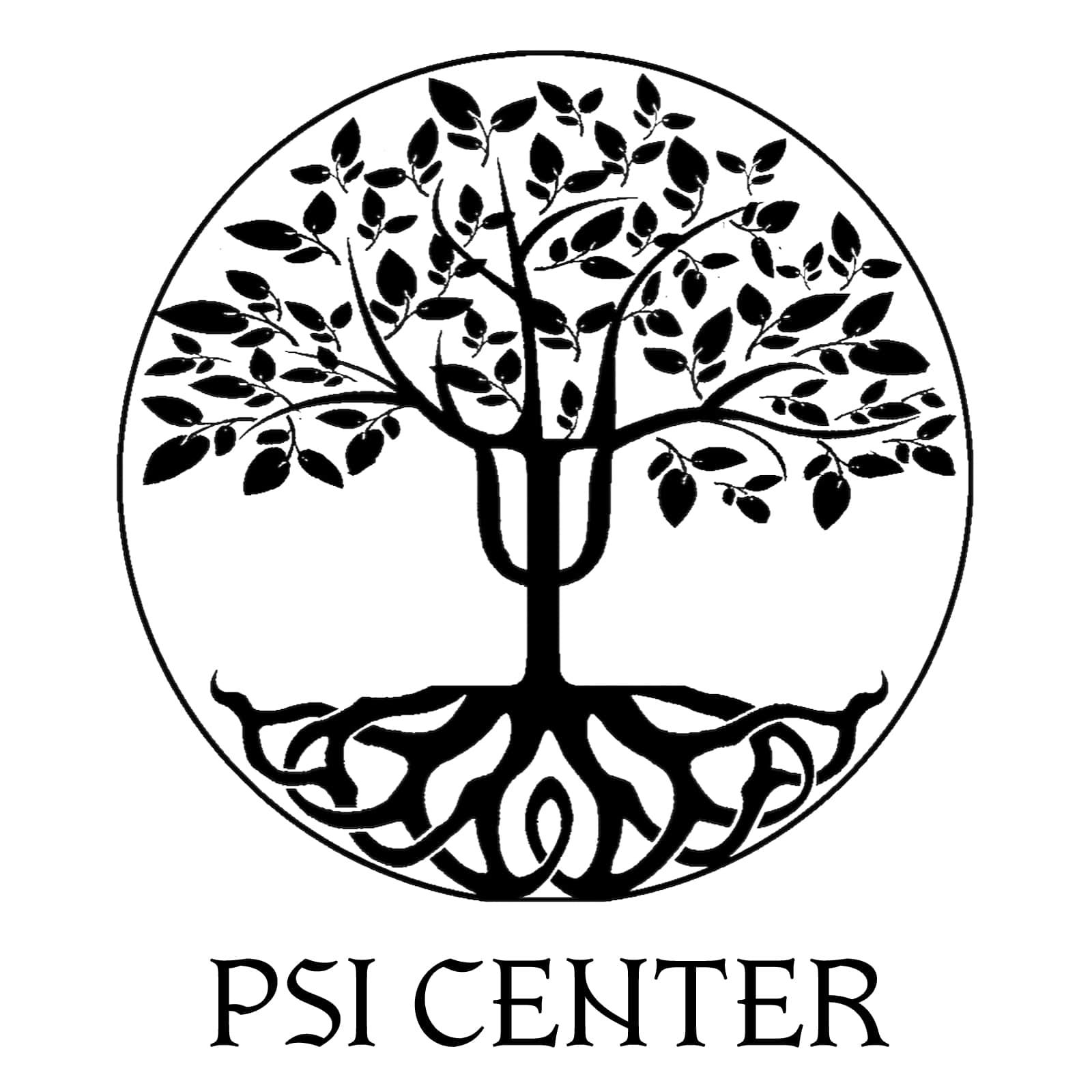PSI RESEARCH CENTER
ψ
NOETIC & PSYCHIC SCIENCE
Relevance and societal impact of Psychic (PSI) Science
Consciousness has been a huge intrigue for centuries amongst philosophers and all the scientific world including many sectors such as neuroscience, clinicians or mathematicians. Nowadays, with the numerous advances in brain imaging and electrophysiological techniques, the mind or mental processes can be related to different correlates occuring at a functional or anatomical level. In the scientific projects developped by the PSI research center, the functional and psychophysical underlying principles with regard to brain processes are investigated in order to deepen into the possible cross-disciplinary occurences between quantum physics (quantum coherence and entanglement) and the brain dynamics at a more anatomical/functional level (inter-brain connectivity patterns). Indeed, broadening the scientific undertaking to other atypical states of consciousness than classical absorptive states (shamanic trance states) seems to be the logical step forward because of apparent similarities between shamans and psychics/mediums (practitioners). Furthermore, the scientific evidence is crucial to grasp the extend to which the practitioners are legitimate to exert their profession and also to create scientific tools to evaluate which practitioners can ensure reliable care services. The groups and sectors which will generally benefit from this scientific research will be the health care system and the scientific community. Indeed, the results could possibly root change towards a scientific paradigm shift around consciousness by taking into consideration the reality of the modified states of consciousness. Finally, the proposed interdisciplinary approach and the possible combination of many different fields (philosophy, psychophysics, cognitive neurosciences and holographic principles) will be crucial to advance the current state of the art around consciousness.
The Psychic Research Center – Consciousness Research targeting anomalies
Consciousness is a puzzling mystery in the philosophical world and for cognitive neuroscientists. Large-scale brain complex dynamics including coherence patterns within the brain sustain a higher degree of consciousness (Demertzi et al., 2019), suggesting that conscious phenomena are not restricted to small-scale neuroanatomical constraints. However, there is still little evidence on complex/large scale electromagnetic patterns for information sharing and integration. By investigating the « Einstein-Podolsky-Rosen » (EPR) paradox in the brain [a quantum-like entanglement occurence between brains of two individuals], a general underlying psychophysical principle might be revealed as quantum coherence between the overlapping electromagnetic fields of the two brains.
With regard to abnormal bodily perceptive states, an inhibitory repetitive transcranial magnetic stimulation (rTMS) protocol (Exp.2) can be used to assess the causal role of TPJ and cortical desynchronization in autoscopy (AS) or out-of-body experience (OBE). The combination of the results from both experiments with autoscopic phenomenological inquiries, will highlight the extend to which modified states of perceptual bodily self-awareness occur and might reveal the principles of cortical synchronization across the cortex for embodiment.
The psychic research center aims at filling this gap, conducting strict scientific investigations to overcome the current lack of definitive comprehension of conscious phenomena and modified states of consciousness.
The main objective consists in paving the way toward a paradigmatic change around consciousness studies based on science. Accordingly, the articulation of a theoretical framework starting from the different findings and evolving toward a conceptual frame will be paramount. The final step will be to extrapolate the results into a compound of related theoretical pathways or integrative science such as the conscious electromagnetic information (CEMI) field theory of consciousness, The Penrose-Hameroff model, coherence/resonance general theory of consciousness, the integral relativity of awareness and energy (Dr. Lex Neale) and the holonomic brain’s theoretical axis (Dr. Karl Pribram) including an unconstrained fourier coordinate system and holographic principles (cymatics in the EM brain waves).
The two adding topics of scientific endeavour in the PSI research center are biomagetism and sound healing, more detailed explanations on the dedicated pages.




Global Scientific Focus
1. The Eintein-Rosen-Podolsky Paradox or Quantum Entanglement in the Brain and between distant brains.
2. Abnormal bodily perception identified as autoscopy or Out-of-Body experiences.
3. The significance of kirlian imagery in science.
4. Biochemical changes post-treatment with biomagnetism and focused sound therapy interventions.
Scientific Apparatus
1. Dual Electroencephalography (Dual EEG).
2. Transcranial Stimulation (TMS).
3. Kirlian Imagery.
4. Biochemical Laboratory Indices.
5. Faraday Cage.
State of research in Consciousness Studies
Consciousness is one of the greatest mystery of mankind. In the past decades, there has been a flourishing amount of scientific interest towards what is commonly named : “ The modified states of consciousness “. From autoscopic to out-of-body experiences (OBE), the Einstein-Podolsky-Rosen (EPR) paradox in the brain or absoptive trance states opened up scientific paths to decipher the nature of modified states of consciousness (Flor-Henry et al., 2017; Gosseries et al., 2020; Grinberg‐Zylberbaum et al., 1994; Hove et al., 2016; Wackermann et al., 2002). Absorptive states have slowly begun to trigger curiosity of the scientific world during the past decades. Indeed, several neurophysiological indices such as a right hemisphere dominance (Krippner & Combs, 2002), increased theta power (Jacob, 2015), a synchronization between left and right frontal lobes coupled by progressive frontal hypoactivation in deeper states of trance (Lehmann et al., 2001) are the current most-known correlates of absorptive states. However, it must be pointed out that the right hemispheric activation has been associated with many altered states of consciousness such as depersonalization/derealization, autoscopy, out-of-body experiences or self-dissolution meditative states (Lehmann et al., 2001). The current missing point is clearly psychic states demanding more scientific inquiry. Psychic states may be defined by a condition where a clear impact is visible from one brain (the psychic) towards another brain or towards waves/matter. Accordingly, the general goals of the PSI psychic research center is to investigate the “The Einstein-Podolsky-Rosen Paradox” (EPR paradox) in the brain including the related neural activity (Exp.1), and assess causal relationship of a key region for bodily consciousness in orchestrating the whole-brain neural dynamics associated to altered bodily states. The EPR paradox appears as an argument from three physicians (A.Einstein, B.Podolsky & N.Rosen) which stipulated that quantum mechanics missed additional variables that must restore causality and locality. It corresponds to non-local phenomena such as quantum entanglement that might be sustained by unknown hidden variables. Currently, some research is showing that consciousness is not restricted to constrained anatomical pathways. Instead, neural coalitions including signal fluctuations generating a highly integrated state by the mean of large-scale complex dynamics, seem to be the cornerstone of conscious phenomena (Demertzi et al., 2019). Accordingly, consciousness might occur when highly synchronized or coherent states are apparent in the brain sustaining a non-reductive philosophical axis to interpret consciousness. However, there is still need to demonstrate (a) the neuronal communication through neuronal coherence/resonance (Hunt & Schooler, 2019) and (b) the assumption that quantum coherence and entanglement might occur within brain processes or between invididual’s brains (EPR paradox). Additional components of conscious processes might be related the EM fields, analogous to the well-known microstates (McFadden, 2020), and the holographic storage processes by means of interference patterns within the dendritic network of pyramidal cells, defined by the holonomic brain theory (Pribram, 2011). To fill this gap, the main theoretical hypothesis is that quantum entanglement between brains and the disruption of corporeal self-location (OBE) following a brain inhibition suggests that conscious processes lie effectively within electromagnetic waves information sharing processes (coherence/resonance/interference and entanglement) and could give credit to the two main theoretical axis (a & b). To establish the neurophysiological underpinnings of consciousness, scientific undertaking will focus, firstly, on what is called “quantum entanglement” or non-classical correlations between two brains implicating non-locality (Exp.1). Quantum entanglement in macroscopic systems is well-known in the current scientific world. Indeed, biological systems as well as large and hot systems might have evolved to use quantum entanglement as an adaptative advantage (Vedral, 2008). Many experiments are directly linked to each of these general hypotheses as the EPR paradox in the brain might support that the quantum coherence assumption is theoretically valid for brain research (Streltsov et al., 2017; Grinberg‐Zylberbaum et al., 1994). Accordingly, physics shows us that coherence and interference are general psychophysical features of electromagnetic waves (Streltsov et al., 2017) and quantum coherence seems to be a prerequisite for entanglement where nonzero coherence can be used for entanglement creation (Streltsov et al., 2017). Thus, with regard to the hypothesis that non-local correlations can be revealed by Exp.1 around EPR paradox in dual electroencephalography research, we can explore to what extend quantum entanglement, and possibly quantum coherence, might occur between brains. The general assumption for Exp.2 is that large-scale complex dynamics (pattern 1) might have an underlying theoretical principle which is : neuronal coherence or resonance mainly known as neural synchrony. The general idea behind neuronal coherence is that : « only coherently oscillating neuronal groups can interact effectively, because their communication windows for input and for output are open at the same time » (Fries, 2005).
With regard to disembodiment phenomena due to altered body perception (ABP) and regrouping autoscopy (AS) and out-of-body experiences (OBE/180° body reversal), the common view sustains that the temporoparietal junction (TPJ), especially the right hemisphere, is the neural hub to convey multisensory body-related information and builds a coherent sense of body ownership (Blanke et al., 2002). Indeed, multisensory conflicts seem to be the cornerstone of abormal body perception (Ionta et al,. 2011) and phenomenological changes in perceived body ownership seem to follow the progressive stimulation of right TPJ (Blanke, 2000). However, further investigations reported controversial evidence. On the one hand, also the left TPJ seems to be involved in disembodiment (Bos et al., 2016). On the other hand, TPJ is not the only brain region implied in body ownership since, for instance, abnormal body perceptions have been associated with the medial occipitoparietal junction (Jonas et al., 2014), occipital cortex (Daltrozzo et al., 2016), precuneus/thalamus (Dirk et al., 2007), and thalamo-occipital radiations (Smith & Messier., 2014). This large synchronous functional network is known to be involved in reflective self-awareness (Kjaer et al., 2002). Interestingly, the activation process of the funtional network never lead to disembodiment but only to autoscopy (without large changes in visuoperspective and location). Indeed, a deactivation/desynchronization process along a highly functional network might be linked to OBE. In sum, the specificity of the rTPJ for ABP is controversial and a systematic decrease of EEG power is found in all frequency bands, suggesting that a cortical deactivation/desynchronization (possible reduced connectivity) is correlated with ABP. One possible reason of this inconsistency is that most of the previous studies (1) were focused on only one TPJ (left or right) and (2) did not include the analysis of global brain dynamics following the manipulation of neural activity in TPJ.
To fill this gap, the PSI research center focuses the scientific effort towards the desynchronization hypothesis thatwill be tested when both TPJs are inhibited. In particular, in Exp.2 a possible desynchronization occurence will be pinpointed by EEG power spectral analyses and linked to the possible ABP. The main scientific step forward compounding both experiments consists into experimentally proven non-local correlations between brains (EPR paradox) and to figure out whether the blockage (inhibition) of both TPJs will trigger large desychronization process (highlighting underlying global brain dynamics) and disembodiment. This approach will reveal whether different altered states of consciousness have common features : coherence/sychronization specific patterns that might be one of the crossing link between the three experiments (Exp.1a, Exp.1b, Exp.2) and theoretical unfolding, that will be explained fully in the dedicated pages.

